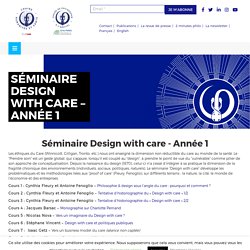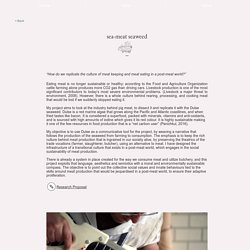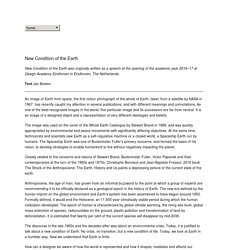

Plateforme « Art, design et société » Séminaire Design with care - Année 1 - Chaire de Philosophie à l'Hôpital. Les éthiques du Care (Winnicott, Gilligan, Tronto, etc.) nous ont enseigné la dimension non réductible du care au monde de la santé.

Le “Prendre soin” est un geste global, qui s’appuie, lorsqu’il est couplé au “design”, à prendre le point de vue du “vulnérable” comme pilier de son approche de conceptualisation. Depuis la naissance du design (1870), celui-ci n’a cessé d’intégrer à sa pratique la dimension de la fragilité chronique des environnements (individuels, sociaux, politiques, naturels). Le séminaire “Design with care” développe les problématiques et les méthodologies liées aux “proof of care” (Fleury, Fenoglio), sur différents terrains : la nature, la cité, le monde de l’économie et des entreprises. Cours 1 : Cynthia Fleury et Antoine Fenoglio – Philosophie & design sous l’angle du care : pourquoi et comment ? MA Material Futures Catalogue 2019 by Central Saint Martins. Chiara Tommencioni Pisapia uses moths to break down unwanted clothing. Central Saint Martins graduate Chiara Tommencioni Pisapia has proposed a method for improving the textile recycling process by using moths to break down the natural fibres in discarded clothing.

Pisapia, who says she is "interested in sustainability related to fashion, textile recycling, bio-design and the circular economy", wanted to find a more efficient way to deal with mixed-fibre textiles, which are currently complicated to recycle. These textiles, containing a combination of manmade and natural fibres such as wool and polyester, typically end up in landfill or incinerators as it is difficult to separate the fibres for recycling. "Textile recycling is currently done mainly using chemicals or mechanical methods," the designer told Dezeen. "As we are in a time where biology and design are interweaving, I thought it would be interesting to explore how nature is recycling and breaking down fibres and this brought me to look at clothes moths," she added. Sea-Meat Seaweed. Sea-meat seaweed “How do we replicate the culture of meat keeping and meat eating in a post-meat world?”

Eating meat is no longer sustainable or healthy; according to the Food and Agriculture Organization cattle farming alone produces more CO2 gas than driving cars. Livestock production is one of the most significant contributors to today’s most severe environmental problems. (Livestock a major threat to environment, 2008). However, there is a whole culture behind rearing, processing, and cooking meat that would be lost if we suddenly stopped eating it. My project aims to look at the industry behind pig meat, to dissect it and replicate it with the Dulse seaweed. My objective is to use Dulse as a communicative tool for the project, by weaving a narrative that follows the production of the seaweed from farming to consumption.
Clemence Grouin-rigaux. Bioplastic - Tools and Recipes by Johan Viladrich. Material Activism. Jan Boelen – New Condition of the Earth. New Condition of the Earth was originally written as a speech at the opening of the academic year 2016–17 at Design Academy Eindhoven in Eindhoven, The Netherlands.

Text Jan Boelen An image of Earth from space, the first colour photograph of the whole of Earth, taken from a satellite by NASA in 1967, has recently caught my attention in several publications, and with different meanings and connotations. As one of the best-recognized images in the world, this particular image and its successors are far from neutral. It is an image of a designed object and a representation of very different ideologies and beliefs. The image was used on the cover of the Whole Earth Catalogue by Stewart Brand in 1968, and was quickly appropriated by environmental and peace movements with significantly differing objectives.
The discourse in the late 1960s and the decades after was about an environmental crisis. But, however significant the perspectives above are, they are all white, male and Western. The rising use of recycled plastic in design is "bullshit" says Jan Boelen. Designers should stop using recycled plastic and instead use bioplastics made from natural materials such as algae if they want to reduce pollution, according to Istanbul Design Biennial curator Jan Boelen.

Boelen described the trend for making products out of reclaimed plastic as "bullshit" and said it helped perpetuate the dependence on fossil-based polymers. "I really, really think it's bullshit," he told Dezeen. "It's doing nothing. It's not changing the fundamental problem we have. " Boelen made the comments while giving a tour of the Istanbul Design Biennial, which opened this week. Earlier this year, young designers told Dezeen that using recycled plastic would soon be the "the only choice".
However, the Belgian curator and educator argued that recycling helps prop up the plastic economy rather than offering a viable solution to environmental contamination. Recycling "relieves our guilt" "A lot of partners have a big interest in it. "We need a systemic change," he added.